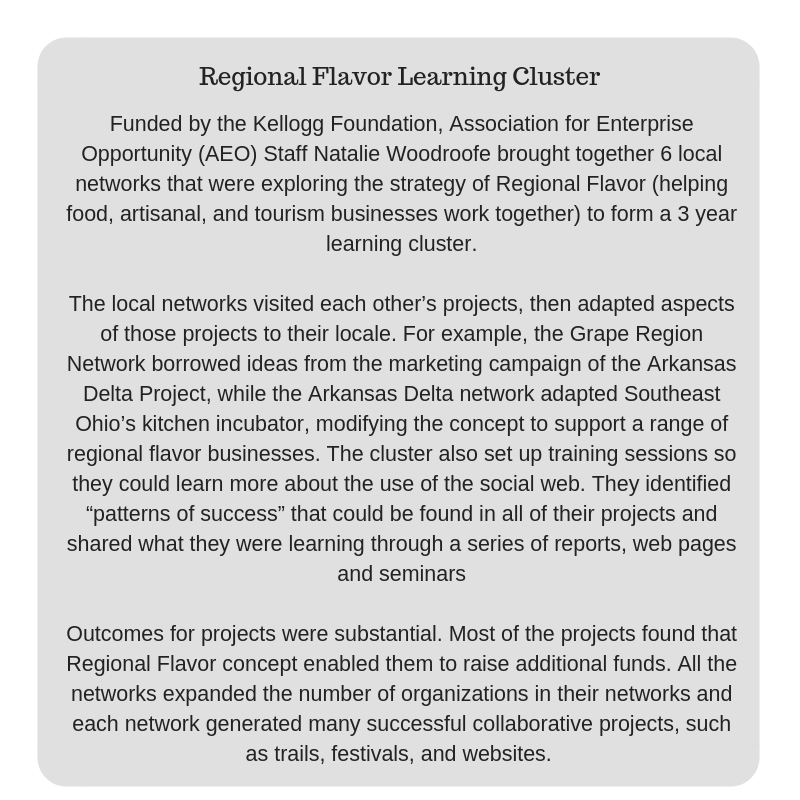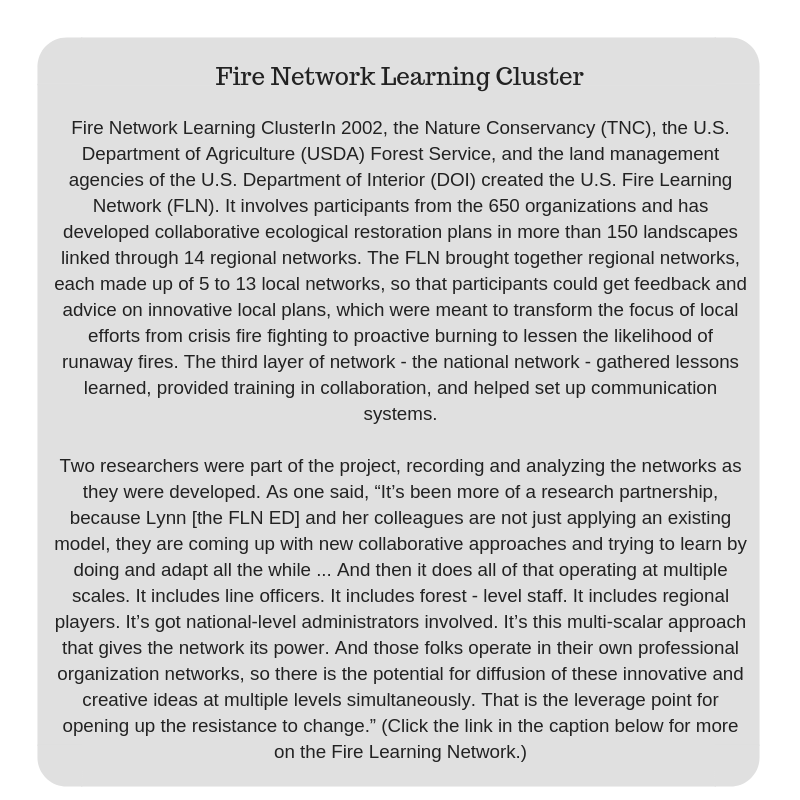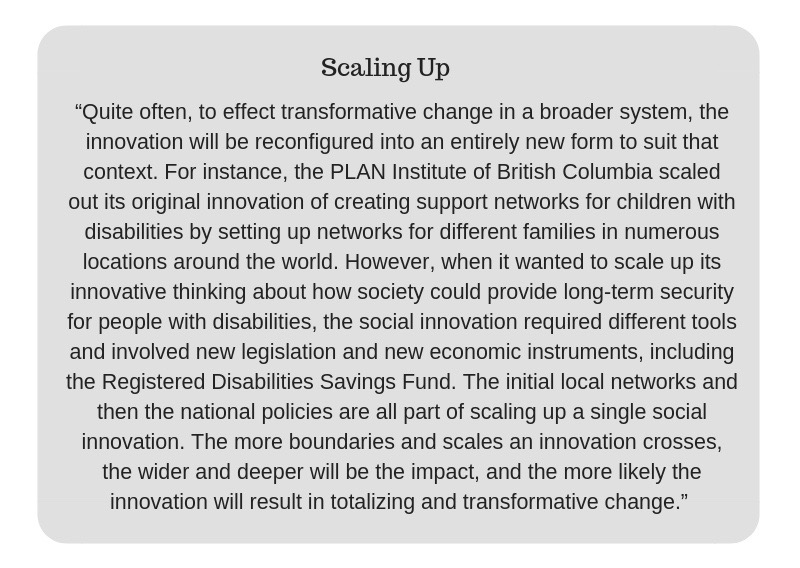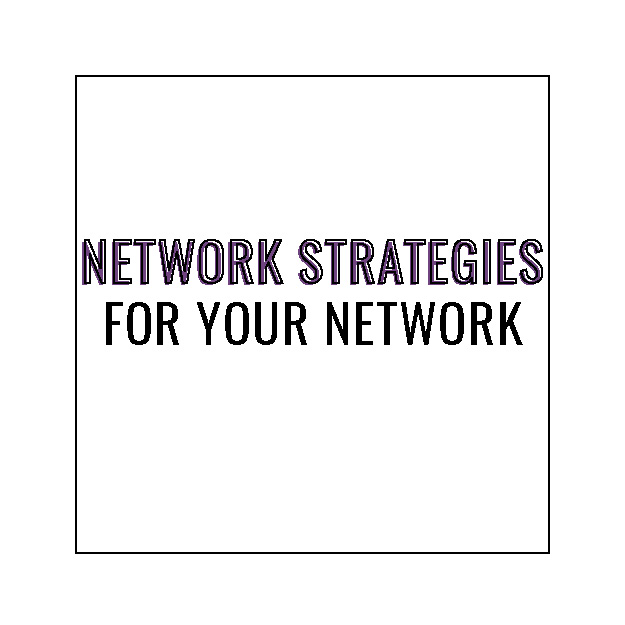Network Weaver Virtual Cafe - Kick-off
[ap_spacing spacing_height="20px"]
Adrian Röbke and Nenad Maljković are hosting a Network Weaver Virtual Cafe kick-off.
WHERE: Zoom link: https://zoom.us/j/158170326
WHEN: February 8th, 2019. 16:00 - 17:00 UTC (in your time zone)
DETAILS:
To further build our global community, we'll begin by getting to know each other and share stories on what brought us to and fascinates us about network weaving.
We will then explore what regular virtual talks can do for us to fulfill our needs and answer some burning questions.
Lastly, there will be a short bit on practical manners: In which rhythm do we want to do the sessions? Who facilitates? How do we fit all of our themes and needs into an exciting format?
[ap_spacing spacing_height="30px"]
Trainings from Visible Network Labs
Many people today are deeply engaged in the “network way of working”, driven by a conviction that working together will make a greater impact than going about any one project alone. Yet, while we are better than ever at getting groups of diverse partners together to work on an issue, there are very few places we can get the Network Leadership skills we need to be successful. This is beginning to change, with a number of organizations filling in the gaps and supporting learning networks, trainings, and peer-learning to build capacity for people to engage in network building. At Visible Network Labs we are committed to providing a diverse set of opportunities for every learner to build their capacity to engage in, coordinate, and lead networks. The VNL Learning Lab is pleased to present a number of Network Leadership Trainings in the coming months.
These include:
- Network Leadership Training Academy
- Network Leadership Webinar Series
- Online Partner Tools Workshops
The focus of the VNL Learning Lab
trainings is on skills to Build, Manage, and Evaluate effective
networks. While these trainings will continue to focus on the most
important aspects of Network Leadership, this Spring is an exciting
time for the advisory group planning the training, as we begin to
think about how innovation and alternative structures can move
networks to the next level.
- Building Networks: While we continue to focus on important topics such as awareness of equity, inclusion, and diversity in network voice, participation, and decision-making, upcoming trainings will be integrating innovative thinking into network building with training and talks on Design Thinking in networks, with a focus on stakeholder involvement in ideating, experimentation, and adaptive processes in network building.
- Managing Networks: Our focus will continue to provide the tools and skills for facilitating, administrating, and governing networks, but our 2019 trainings are going to dig deep into alternatives for governing networks – looking at self-governing structures, empowerment models of leadership and governance, developing the business model for networks, and developing shared governance models. We are also introducing skill building on how to move forward with heart while selling our mission to convince others to invest their time, energy, and funding - and how we can feel good about it.
- Evaluating Networks: The availability of tools, models, and frameworks to tell our network stories and demonstrate their effectiveness is more exciting than ever. We will focus on sharing the opportunities inside our own Aspen platform for this work, while highlighting options that meet the different needs of networks. In 2019, we are focusing on all the myriad ways to tell our network stories with color, data, truth, and impact.
CLICK HERE for a complete list of Visual Network Labs' 2019 offerings.
Three Workshops from New Directions Collaborative
About ten years ago, I was working with a non-profit organization in the field of sustainability and social change, and was invited by a funder to a conversation with about 15 other organizations to explore about how we could align our work and consider working as a network.
From that initial experience of finding how to connect and amplify the work of many organizations, I have had the opportunity with New Directions Collaborative to work as a facilitator of a range of network initiatives across issues such as climate action, local food systems, smart growth, racial equity, and educational attainment.
It has been a fascinating learning process of seeing what is needed to work in these networked ways for the greatest impact. One of my favorite aspects is learning to work with the idea of "emergence," where we create conditions for new relationships, flows of information, deeper understandings, and innovative ideas to arise out of the whole group in ways we couldn't have predicted.
There is an art to this kind of collaborating and I have learned from diverse sources of ideas and methods, e.g., from others in this Network Weaver community and other fields, such as Art of Hosting. Many traditional leadership programs do not train people in how to "work as part of an ecosystem." Last fall, I decided to distill the approaches and tools I was regularly using in my work into a series of training workshops that I offered in person in New Hampshire. The response was so encouraging and I had requests to offer on-line workshops so more people could participate.
Starting in February, I will host three workshops.
- The first focuses on how to design meetings to generate multiple benefits, such as pooling our knowledge for collective sensemaking, strengthening relationships and spurring micro-collaborations.
- The second explores the leadership skills and qualities needed to host collaborative work.
- The third workshop builds skills in how to work as part of a larger system and help that system align and be more effective. All of these will be held on Zoom and be interactive, where you get to experience of participatory meeting methods, and see how they can work on line as well.
CLICK HERE for details of the workshops - hope you might join and help spread the word!
Awareness Activities
A lot of research has been conducted lately to identify how awareness or mindfulness operates in our brain, the benefits of this mental state, and how we can spend more time in a mindful state. This research is of great value to Network Weavers. Two excellent books on the topic are Your Brain At Work by David Rock and Mindsight by Daniel Siegel. Also, consider exploring Researching Your Own Practice: The Discipline of Noticing.
Mindfulness occurs when we are able to step back from our present situation and reflect on what is occurring in a detached fashion. This state is extremely helpful to Network Weavers because it enables us to temporarily suspend our positions, emotions, or arguments and get a bigger and more nuanced sense of what is occurring. This opens the opportunity to act in new, refreshing ways: to appreciate the other, to listen more deeply, to notice potential.
The Awareness Activities in this handout can help us become more aware of what is happening around us.
[ap_spacing spacing_height="30px"]
The Power of Networks
If you’re like most nonprofit leaders, you’re devoting significant effort to your networks. But what return are you seeing on that investment?
I recently spoke with 500+ nonprofit leaders at Nonprofit Driven 2018 and emphasized 3 simple truths about strong, impactful networks.
[ap_spacing spacing_height="30px"]
1. Network leadership is different from organizational leadership.
[ap_spacing spacing_height="10px"]
Organizations tend to have strong, stable structures and centralized decision-making. Leaders prioritize goal achievement, alignment and retention.
Networks are loose, unstructured webs of relationships. People are engaged in autonomous yet connected activities to achieve a shared purpose. Activities are emergent and often undefined; people come together when there is energy and opportunity. Network leaders have to be humble co-leaders that lift their gaze above individual organizations to see a greater purpose.
[ap_spacing spacing_height="30px"]
2. Networks are grounded in trusting relationships.
[ap_spacing spacing_height="10px"]
The success or failure of networks can usually be traced to the condition of their relationships. Like any relationship, trust is key. Easy to say, but how do you do it?
[ap_spacing spacing_height="15px"]
I. Visualizing your network can offer powerful insights.
Network mapping can be a powerful trust building process, especially when you engage network members in making sense of it together. Seeing the system of relationships can illuminate barriers and opportunities to build equity and trust.

In some networks, one person (the hub) knows many individuals who aren’t connected to each other (spokes). This can limit and potentially block the flow of information and resources.

II. Closing triangles.
Hubs need to “close the triangles” – build relationships between disconnected people. Closing triangles is a key strategy for weaving ecosystems of trust in which:
• People are meaningfully engaged
• There aren’t gatekeepers
• Diverse perspectives can be fully integrated, and
• Leadership is shared.

III. Set the table for inclusion.
How you set up a room, design an agenda and facilitate a dialogue can either limit or build engagement and inclusion. I recommend Liberating Structures, a set of creative yet systematic facilitation tools that leverage everyone’s contributions.
[ap_spacing spacing_height="30px"]
3. Networks enable community building and social impact.
[ap_spacing spacing_height="10px"]
To make a social impact, networks also need to take collective action. Here are four essential practices:
[ap_spacing spacing_height="15px"]
I. Foster shared purpose.
Shared purpose sustains momentum. Prioritize the purpose and align your strategy to realize it.
[ap_spacing spacing_height="15px"]
II. Foster co-creation.
Mechanisms like Liberating Structures and purpose-driven working groups enable co-creation and build shared ownership.
[ap_spacing spacing_height="15px"]
III. Foster collaborative leadership.
Shared power is key in networks. Regularly analyze how the network is functioning, close the triangles and guide the work together.
[ap_spacing spacing_height="15px"]
IV. Foster generative learning.
Make space to reflect and gather the collective wisdom. Nurture a culture of curiosity and develop agility through learning.
Have you unleashed the power of your networks? Integrating these 3 simple truths and a few proven practices can help make your networks effective and impactful.
[ap_spacing spacing_height="10px"]
Lisa Watson is the Co-Founder & CEO of Openly, a strategy, research and design firm enabling changemakers to achieve social impact. She is also a faculty member at the Banff Centre for Arts & Creativity.
Originally Published on November 8, 2018 at Hilborn: Charity eNews
[ap_spacing spacing_height="15px"]We encourage you to comment on this post so we can hear about your thoughts and experience.
Transformative Networks Are Multiscalar
[ap_spacing spacing_height="30px"]
This is an excerpt from the Network Weaver Handbook. I'll be writing an update with my latest research and thinking on the topic in the coming weeks so stay tuned! - June Holley
[ap_spacing spacing_height="25px"]
How does transformation of our systems happen?
In the 1950s, researchers developed a model of the diffusion of innovation where, when influential individuals adopted an innovation, that practice or idea would spread rapidly among the rest of the population. In this model – still favored by many marketing strategists – all you had to do was to identify influential individuals, convince them that your product was superior, and their influence would ensure that many other people adopted your product. The adoption of the use of hybrid seed corn in the 1950s and the fad of hula hoops were touted as successful examples of this type of innovation diffusion.
"The critical question is whether an how social networks can help facilitate innovation to bridge the seemingly insurmountable chasms that separate local solutions from broad system transformation."
- Michele - Lee Monroe and Frances Westley
More recently, Duncan Watts, a researcher in the area of complex networks, refuted this simple approach to the diffusion of innovation. He showed that whether an idea or practice is spread by an influential person is highly probabilistic – sometimes spread happens and sometimes it does not. Spread depends much more on the kind of network surrounding the innovation than on the kind of individual advocating an innovation. For example, if networks bridge across clusters so that there is now a larger network, innovations can flow to a larger set of practitioners. Also, networks where people are working in many projects, each with somewhat different participants, are likely to see innovations spread quickly. When a useful innovation arises in one project, the individuals in that project are likely to tell all their other projects about the innovation.
"Scale the edge, not the core."
"Building on this, we have discovered that creating multiscalar networks – networks that cross levels or layers – are what turns innovation into widespread systemic transformation. We have identified specific patterns of 3 layers of interconnected networks that can bring about this transformative effect. People working in an issue or vision area need to make sure that they are part of all three if they want maximum impact.
- Level 1: Build local networks for experimentation
- Level 2: Build networks for scaling out so that local innovations can spread, inspire, and learn from others
- Level 3: Build networks for scaling up so infrastructure and policy to support innovations can be developed
LEVEL 1: Local Innovation Networks to experiment
"Scaling across happens when people create something locally and inspire others who carry the idea home and develop it in their own unique way."
-Margaret Wheatley, Walk Out Walk On
Chapter 10 described the process for creating a maximally innovative local network. However, there are two additional aspects of local networks that enable them to effectively link to networks at other scales:
- Development of an effective periphery for spreading ideas
- Expansion or spread of local networks for increased impact
The phrase, “Scale the edge, not the core,” describes the importance of developing an extensive periphery for your local network. Much of that periphery will be located outside of the local community. People in the periphery who help the local network be maximally innovative are:
- People in other communities around the world working in the same issue or vision area who can offer new ideas and practices
- People in other communities who are interested in what the local community is doing
- People who are connected to other disciplines or sectors and might have new insights or identify ways the two sectors could combine efforts
Another aspect of local innovation networks is that they encourage local groups to obtain a more sophisticated understanding of the entire system that their issue is embedded in and encourages them to work with others to address issues systematically. So, for example, a network working on prison reform might start to work with jobs programs and entrepreneurship organizations to develop better re-entry programs and, at the same time, work with a community development network on ending racism-related sentencing.
Many local food system networks have joined with artisan organizations and other local businesses to create healthy local economy initiatives. Other local food system networks have expanded their network to include those working on anti-obesity efforts. Transformation begins as projects increasing connect with projects working on other aspects of the system, thus amplifying their impact. Other fields (immigrant reform, criminal justice, reproductive rights, poverty, etc.) could all benefit from this type of local expansion of their networks.
Activity: Expanding your local innovation network
On chart paper or large whiteboard, have people in your network identify organizations and individuals they could add to their periphery to access new ideas. Then, using another color have them identify organizations that are interested in their local experimentation and with whom they might share what they are learning. Identify individuals in the local network who will seek out and/or stay in touch with each.
Using another color, identify local organizations from somewhat different fields but interested in some of the same problems or issues with which they might have discussions on how they could work together. Determine which are the highest priority. Who will reach out to them?
LEVEL 2: Scaling out networks
"Information can leap from group to group even when those groups seem to have nothing in common, because all they need in common is a single individual who is member of both groups and therefore has a bridging identity."
-Paul Hartzog
In the 20th century, many foundations funded efforts to replicate best practices. We know now that replication is an inadequate concept for the complexity of social problems we are working with for three reasons:
- Most projects need to be adapted to each specific community to be fully effective.
- Most projects can still be improved and so shouldn’t be replicated slavishly.
- Specific projects are still only one piece of a very complex problem or system and without integrating a number of system elements at the same time project success is likely to be limited.
Still, there is a lot of great experimentation happening in communities. For other communities to benefit from this requires a scaling out network. A scaling out network has four different aspects
- Support the spread of innovations
- Develop systems for determining which local efforts are worth scaling
- Support learning clusters of organizations working on similar strategies
- Support rhizomatic acceleration: research, venues, and leadership for scaling out
1. Scaling out by supporting spread
People in local networks need to be encouraged to share information about their innovations wherever they go. Funders need to provide incentives for successful innovative projects to coach other communities as they adapt that innovation (see the Saving for Change example below). Funders might have grantees suggest groups/networks they want to learn from, then help these identified innovators set up training sessions, site visits, or coaching.
Actually much informal sharing is already occurring, and it would be valuable to identify groups or individuals who have been very successful at informal sharing and document their methods and practices through case studies.
One of the best ways for people to learn about innovations is through stories about those innovations. The success of the RE-AMP case study by the Monitor Institute shows that there is a huge need and market for high-quality case studies. In fact, it would be great to have web sites where sets of case studies were collected, along with notes from conversations people had with each project so that a deeper and more complex perspective is available. People need to be able to take a “deeper dive” into the case study by asking questions of those involved in the innovative project or network. If such sites also had discussion forums, then we would be able to easily see which projects appeared to be attracting a lot of attention and funders could direct more resources to those innovators
2. Scaling Out By Developing a System for Identifying Projects for Scaling
Not all projects are worth scaling. How can projects be evaluated to help others determine whether they are effective? Initially, promising projects may not show clear outcomes but will have deeply embedded processes for reflection and learning that will enable them to continue modifying their approach until it produces results.
We need Network Guardians who are exploring issue areas at a meta-level, identifying projects that are tackling similar problems but using different approaches and noticing those projects that, in addition to showing early promise, appear to have a lot of energy and attraction.
The United Nations (cited in Critical Choices by Reinicke and Deng) calls this role a network entrepreneur. A network entrepreneur identifies niches where conditions are right for launching new global public policy networks and takes steps to initiate formation of a new network. Foundations and national networks could also help identify areas where scaling could be most beneficial. BALLE is an example of a national network that is identifying a variety of innovations that can fill the need for local access to local capital for local businesses.

3. Scaling Out Through National Learning Clusters
Learning clusters are one of the most underused and underfunded strategies for scaling projects. They are the second level in a multi\scalar network and critical for transformation. A learning cluster is a set of local network projects from different communities whose participants are brought together regularly (virtually and/or face-to-face) to share about strategies they have developed, build skills, and learn from each other. It is through intensive reflection by these initiatives that key leverage points for system change can be identified for an entire issue area.
Clusters can be composed of innovative network projects that are already underway or of local networks just embarking on a strategy (or, ideally, mixtures of both). In most cases, each project will be unique: variations among the strategies, in fact, are encouraged so that participants can continually learn from each other.
Three critical ingredients of learning clusters are:
- Highly skilled facilitation
- Attention to building deep network relationships among the participants
- Diverse participants from each participating local network (different types of organizations, individuals of different ages and backgrounds)
In learning clusters, projects are introduced to the innovations of other groups, and at the same time, the cluster as a whole looks for the critical elements among all their projects that lead to success. Clusters can provide peer assists (sessions where one project outlines a challenge and the other projects ask questions, give ideas and advice, and share information about resources). Each local group also gets assistance from the rest of the cluster as they adapt model projects from other cluster members to their particular locale. The entire group also provides support for each local project as it continually improves and refines its strategy.

Many learning clusters that have been set up by funders have not been successful because the local projects have not been the initiators of the convenings and have not been able to have a say in the selection of their learning partners. Learning clusters take surprisingly few resources to operate, but dissemination of findings to larger groups in the field and handbooks that capture the cluster’s recommendations on implementation both need to be part of the overall project.
Activity: Create A Learning Cluster
- Identify 6 to 12 organizations working in your issue area that you would like to learn more about.
- Have sets of twosies in your network, select an organization each to call and interview.
- Identify the ones that are most innovative. Find out if they would be interested in being part of a learning network.
- Identify a source of funds to support coordination of the learning clusters.
4. Scaling out by supporting Rhizomatic Acceleration: Research, venues, and leadership for continued scaling out:
The concept of rhizomatic acceleration is key to successful scaling out. When we study a ginger rhizome we learn that every bud of ginger has the nutrients to generate and support many other buds. As a result, ginger rhizomes can expand rapidly without any central authority (see photograph below).
How do we implement a rhizomatic approach?
- We ensure that all Network Weavers learn how to help others become Network Weavers.
- We make sure that individuals who are part of collaborative projects are made aware of the skills, processes, and platforms that are being used in that project, and are encouraged to use these in other projects of which they are a part.
- We make sure that network participants have many platforms and venues for sharing what they are doing in ways that others can adapt their innovations.
In addition, research teams (including practitioner and professional researchers) using a developmental evaluation approach need to be embedded in learning clusters from the start so that they can record what is happening transparently and as the learning cluster is unfolding. Developmental evaluation uses a complexity lens to understand what is being developed through innovative engagement.
By sharing information and insights as the learning cluster progresses, other local networks can be adapting what is learned in their locale even before the learning cluster has concluded. Webinars, gatherings that piggyback on conferences, and interactive websites – all can become venues for sharing out what is learned in the clusters.
In addition, participants in the first learning cluster could then become coaches and trainers in a second, larger learning cluster. In this way, learning clusters become rhizomatic accelerators to the extent that the initial participants become skilled at and willing to share what they have learned with other local networks.
Like ginger, where every node has the nutrients to support the budding off of many other nodules, learning cluster participants need to be encouraged and incentivized to help many others adapt their strategies (see Michael Quinn Patton’s Developmental Evaluation

[ap_spacing spacing_height="40px"]
LEVEL 3: Scaling Up
Transformation is unlikely to occur simply by having many communities adopt innovations. Not enough communities will find out about the innovation, not enough resources will be available even for those communities that do want to adopt innovation, and not enough connections among the innovations will occur for a tipping point to be reached. In addition to scaling out innovations, scaling up mechanisms need to be set in place.
Scaling up is the use of policy, platforms, strategy, and meta-networks to accelerate the spread of innovation. Scaling up has typically been accomplished by control-based mechanisms. Often corporations scale up by creating franchises (think McDonalds) where each local fast food restaurant is identical to every other unit – with all units controlled by a central office. This method of scaling up can produce rapid growth and substantial profits, but has resulted in many unintended consequences such as our current obesity epidemic with its horrific impact on quality of life and skyrocketing medical costs.
Another example is the No Child Left Behind legislation which mandated a system of testing for school children and led to “teaching for the test.” This policy required all schools to operate in this way and is an example of scaling up through control and homogeneity. The problem with this path to scaling up is that mandated policies don’t always accomplish their intended goals – as has recently been shown by the flat test scores for all grades. When this happens, our entire society suffers. “One size fits all” policies are seldom successful for issues as complex as education, since students and their communities vary so greatly that a single policy is unlikely to work everywhere.
Network systems offer a healthier and more useful model for scaling up, especially in situations where we are grappling with complex problems and systems: Regional or national meta-networks. A meta-network is a network of local or regional networks. Such networks enable rapid scaling up through the use of:
- System analysis for identification of leverage points
- Network Guardians
- Clustering into working groups or action groups to focus on leverage points
- Pooled funds
- Communication platforms
- Policy networks
The time is right for the formation of more intentional meta-networks for many issue areas. We now have enough experience with networks so that we can create structures that are likely to succeed, and the potential to increase impact is great.
Support for meta-networks
Scaling up is best accomplished through regional, national or international meta-networks that focus on a particular issue, problem, or system development area. Meta-networks can either be formally organized, as in the case of RE-AMP, or informally organized, as is the national network focused on supporting local food systems.
Informal Meta-Networks
In an informal meta-network, an organization or set of organizations playing the Network Guardian role identify innovations, convene learning clusters around those innovations and access resources for organizations/local networks in the clusters, and then share out the learnings generated by the cluster. They set up funding pools to support the expanding numbers of local networks implementing this innovation and connect sets of learning clusters, each working on different aspects of the system, so that the entire system begins to shift.
As learning clusters unfold, they identify key system elements for success of that strategy and will come up against barriers that will need to be addressed. Many of these elements would be better implemented by a regional or national program requiring new policy to be enacted. An informal meta-network encourages the formation of policy networks to move support for innovations from foundations to government.
For example, the local PLAN networks, described below, discovered that to fully support people with disabilities, they needed to work together to develop a national program that enabled these individuals to save money for a home, education, or a business (without jeopardizing benefits). This required policy networks to be formed to set in place the necessary legislation.

https://www.ecologyandsociety.org/vol16/iss1/art5/
Formal meta-networks networks
More formally organized networks such as RE-AMP set up networks with more explicit structures to help organize work. They have membership and formal structures – such as the Working Groups that RE-AMP set up – to organize the work. They have a set of platforms and venues for sharing information, from an interactive website to regular Working Group calls.
We encourage you to comment on this post so we can hear about your thoughts and experience.
A Network Connector Story
Sometimes a story can convey meaning better than a lecture. This week's free resource is a story from the early days of the Appalachian Center for Economic Network's (ACEnet) Kitchen Incubator describing how staff were network weaving small food producers in our region.
This focus on connecting people is important no matter what type of organization or network you are part of! We'd love to hear your network weaving stories.
Inclusive Networks Are Shaping Our Lives Right Now - Are They Governance?
[ap_spacing spacing_height="15px"]About six months ago I was introduced to a deeply remarkable development – and its even more profound implications – by two people who didn’t know each other and with whom I’ve talked in depth almost every week since then.
[ap_spacing spacing_height="15px"]This development electrifies me. I have long felt that achieving effective, inclusive, decentralized governance would require a major, perhaps insurmountable effort. But these two folks have opened my eyes to an unexpected form of such governance manifesting right now all around the world.
[ap_spacing spacing_height="15px"]What is that emerging inclusive, decentralized form of governance?
[ap_spacing spacing_height="35px"]
COMPLEX INCLUSIVE NETWORKS AS GOVERNANCE
[ap_spacing spacing_height="15px"]These new friends pointed out rapidly increasing activity of networks that embrace
- multiple sectors (public sector, private sector, and civil society)…
- multiple stakeholders (diverse parties involved in various issues and systems)… and
- multiple scales (ranging from local to global).
[ap_spacing spacing_height="15px"]They shared their thrill at seeing this complex activity emerging as a new form of whole-system engagement and governance that could transcend governMENT as we’ve come to know it. (See the examples and analyses referenced at the end of this email.)
[ap_spacing spacing_height="15px"]My companions in this new inquiry and sense of possibility are Tracy Kunkler and Steve Waddell. Both work with transformationally oriented stakeholder networks, Tracy mostly with local and regional systems, Steve at all levels including global networks self-organizing around the UN’s Sustainable Development Goals.
[ap_spacing spacing_height="35px"]
SOME BIG QUESTIONS FOR THE BIG PICTURE
[ap_spacing spacing_height="15px"]Last month, at the Frontiers of Democracy conference in Boston, Steve, Tracy and I presented a session entitled “How Do We Midwife the Emergence of Wise Governance Networks?”
[ap_spacing spacing_height="15px"]Our session description asked a few additional questions:
- Are you sensing new patterns of societal governance in multi-sector networks?
- Are they more diverse and adaptive to the scale and pace of change than governments?
- Might they become powerful governance structures, growing to include government, but also transcending it?
- How can we influence the emergence of these to be democratic, powerful, and wise?
[ap_spacing spacing_height="15px"]Note that by “governance” we don’t mean governMENT (although that’s part of it), but ALL the things groups, organizations and institutions do to shape what happens on the ground to deal with societal issues and goals and how our collective lives unfold.
[ap_spacing spacing_height="15px"]Of course when we look at what governMENTs do, they definitely impact that. But so do businesses and civil society groups. So when a network involves players from the public sector, the private sector, AND civil society, we are talking about a multi-SECTOR network.
[ap_spacing spacing_height="15px"]And if we look at issues (like poverty, human rights, or climate change) or at social systems (like food systems, health care systems, or educational systems), and we find that groups across the spectrum of roles and perspectives are trying to work together to have some kind of shared impact on the issue or system they’re all part of, we are talking about multi-STAKEHOLDER networks.
[ap_spacing spacing_height="15px"]And if any of these include players at various different levels of functioning – local, state, regional, national, international, global, etc. – we are talking about multi-SCALE networks.
[ap_spacing spacing_height="15px"]These are not so much networks of individuals as networks of groups, organizations, and institutions. When they begin to weave together into multi-sector, multi-stakeholder, multi-scale (MS3) networks, they become increasingly inclusive, often by asking “Who else should be part of this work, this conversation?” With true inclusiveness, the level and texture of impact they have – and could have – begins to boggle my mind. They present the possibility of millions of committed eyes, ears, heads, hands, and hearts working together on the ground in every aspect of any given issue or system. (If you are concerned about the possible totalitarian implications of this, please see my asterisked* note below.)
[ap_spacing spacing_height="15px"]And IF they are actually working together effectively – addressing concerns, developing shared goals and standards, seeing beyond narrowly framed interests – what we have is a whole new level of whole-system governance of, by, and for whole systems. By being part of groups who are part of these networks, whoever is involved in a collective challenge or vision can be engaged in addressing it. A tremendous amount of competence, passion, and knowledge can be tapped for positive evolution in that realm – indeed, in all realms.
[ap_spacing spacing_height="15px"]At least that’s the vision I glimpsed, and it hooked me.
[ap_spacing spacing_height="35px"]
PROVIDING A KEY MISSING INGREDIENT
[ap_spacing spacing_height="15px"]When we asked the attendees in our workshop what they were experiencing in their networks, they told us that the unprecedented diversity of the participants was showing up as a real problem. These networks include people from different cultures and worldviews (think governments, businesses, and nonprofits), different sides of various issues, different constituencies, and so on, quite in addition to different demographics, experiences, organizational styles, and more….
[ap_spacing spacing_height="15px"]I realized that many people in the networks I’M connected to – facilitators, mediators, organizational consultants, process designers, conveners, community organizers, and so on – have tremendous know-how that can help people work creatively across differences. (Much of this expertise is reflected in the wise democracy pattern language, most notably in the pattern “Using Diversity and Disturbance Creatively” but actually throughout the pattern language.) Since these roles form a professional category that specializes in helping different people work together effectively, I realized that those professions are a vital ingredient for the successful emergence of this new whole-system form of governance. That role urgently needs to be acknowledged and strengthened as a factor in how all this unfolds.
[ap_spacing spacing_height="35px"]
WHAT ABOUT WISE DEMOCRACY?
[ap_spacing spacing_height="15px"]Talking about all this as a new form of governance immediately raises the question of where We the People are in all this – where are we, the citizens … we, the communities? What is our role and our power? Where exactly do we – or should we – fit in this new governance picture? What public answerability should stakeholder networks have – and vice versa? Should citizen deliberative councils play a major role in focusing the goals of stakeholder networks or reviewing their activities? Might crowdsourcing solutions or priorities engage the public in issues being addressed by stakeholder networks that require whole-community involvement? (Note that Citizen/Stakeholder Balance was part of the wise democracy pattern language long before I met Tracy and Steve.)
[ap_spacing spacing_height="15px"]This focus on stakeholder networks also raises – for me – the question of how we can increase the likelihood that the results of such coordinated whole-system activities are wise. To what extent will these networks take into account what needs to be taken into account for long-term broad benefit? How can we ensure that oft-overlooked sources of wisdom get included in stakeholder network deliberations?
[ap_spacing spacing_height="15px"]I’ve been asking such questions for years as my “wise democracy” vision has developed. I have some thoughts about possible answers, but those thoughts are barely a beginning. Fortunately, people like Tracy and Steve also find these questions compelling, realizing their importance if this emerging governance-through-inclusive-networks phenomenon is going to end up being an actual long-term blessing.
[ap_spacing spacing_height="35px"]
TWO IMPORTANT PIECES OF WISDOM
[ap_spacing spacing_height="15px"]Two big-picture insights about these questions can help guide our thinking.
[ap_spacing spacing_height="15px"]1. First of all, the diversity and scope of the people and groups involved – IF they are truly inclusive and successfully working together – automatically means that a wide range of perspectives, experiences, interests, needs, and information will be taken into account. It is only by including these and taking them seriously that the people in these diverse networks will be able to function well together. And, in doing so, they will inherently be taking into account much of what needs to be taken into account. Because of the diversity of concerns and needs considered, these networks will realize “what’s needed for long-term broad benefit”, thereby moving us a long way towards collective wisdom.
[ap_spacing spacing_height="15px"]2. Secondly, advocates of deliberative democracy have pointed out complementary roles for citizens and stakeholders who function as experts, as embodied in the formula Experts should be on tap, not on top. This formulation is supported by cognitive science that recognizes that facts and reason cannot themselves lead to a decision. They can provide us with much understanding of what is going on in a situation, but in order to make a decision we have to WANT something – which necessarily involves our desires, feelings, values, and needs. Although these can be defended by reason, they can’t be derived solely through reason; they are fundamental. So in a democracy it is the people’s needs and dreams, the community’s values, the common interest that should properly guide decision-making, not experts.
Yes,we the people need the advice of experts like stakeholders and researchers to help us understand the actual conditions and dynamics of life well enough to satisfy our needs and manifest our values in the complexity of the real world. But WE ARE the ultimate experts regarding our needs, our values, our longings, and our everyday experience.
[ap_spacing spacing_height="15px"]So there is potential for tremendously effective wisdom to emerge from the dense diversity and broad reach of inclusive stakeholder networks and the kind collective wisdom about which the wise democracy pattern language offers so much guidance.
[ap_spacing spacing_height="15px"]The inquiry into this prospect, and the work to raise our awareness of it, have just begun. I’d like invite you into both of these. What are your thoughts? What do you think should be attended to and done? What role(s) might you play? Let me know.
[ap_spacing spacing_height="25px"]Coheartedly,
Tom
[ap_spacing spacing_height="25px"]* Networks for surveillance and control are necessarily top-down. What I am talking about here are self-organizing networks of diverse groups and organizations trying to work together. They are not networks of individual agents working at the street level for centralized power. Multi-sector, multi-stakeholder, multi-scale networks are complex, multi-faceted systems that do not lend themselves to oppressive control or co-optation by central authorities, although attention is warranted to ensure that remains true as network governance evolves.
[ap_spacing spacing_height="35px"]
REFERENCES FOR EXPLORING EMERGING INCLUSIVE NETWORKS AS GOVERNANCE
[ap_spacing spacing_height="15px"]
[ap_spacing spacing_height="15px"]
[ap_spacing spacing_height="15px"]
[ap_spacing spacing_height="15px"]
[ap_spacing spacing_height="15px"]
Metagovernance of Governance Networks
[ap_spacing spacing_height="15px"]
Multi-Stakeholder Initiative Database
[ap_spacing spacing_height="15px"]
New York’s Juvenile Justice System
[ap_spacing spacing_height="15px"]
[ap_spacing spacing_height="15px"]
[ap_spacing spacing_height="15px"]
“Global Governance Enterprises: Creating Multisector Collaborations” (2016)
[ap_spacing spacing_height="15px"]
“Multi-stakeholder Processes for Governance and Sustainability: Beyond Deadlock and Conflict” (2002)
[ap_spacing spacing_height="45px"]
Orignially published at tomatleeblog.com on July 9, 2017
[ap_spacing spacing_height="45px"]
We encourage you to comment on this post so we can hear about your thoughts and experience.
[ap_spacing spacing_height="60px"]
A Network Connector Story
[ap_spacing spacing_height="20px"]
First, An Introduction [ap_spacing spacing_height="25px"]
For a long time, we've trained our eyes to see things with edges and boundaries: organizations, countries, selves. Things with edges and boundaries feel manageable and solid. [ap_spacing spacing_height="10px"]
But the world is changing at an alarming rate, and the old ways of seeing are not quite up to the vertigo of a fast-paced universe. We need new ways of understanding our world that take into account new possibilities. [ap_spacing spacing_height="10px"]
So, we start noticing networks –the relationships among people and the patterns those relationships create. Increasingly, we are realizing that it’s through networks that things get done. People go outside teams, organizations, and even countries to connect with those who can help them succeed. And, using social media, we can now collaborate and engage as easily with people around the globe as we can with people in our hometown. [ap_spacing spacing_height="10px"]
We soon start to notice that all networks aren’t the same. Certain patterns in networks, such as a hub and spoke, are great when you want control. But when you need lots of innovation and aren’t at all sure what will work, bringing together people from different networks who have different perspectives and backgrounds can generate transformative experimentation. [ap_spacing spacing_height="10px"]
But bringing together people effectively is not easy. It requires a whole set of new skills embodied in a new role we call a Network Weaver. A Network Weaver is someone who is aware of the networks around them and explicitly works to make them healthier (more inclusive, bridging divides). Network Weavers do this by connecting people strategically where there's potential for mutual benefit, helping people identify and join with others around their passions, and serving as a catalyst for self-organizing groups. [ap_spacing spacing_height="40px"]
A Tale of Network Connecting [ap_spacing spacing_height="20px"]
Nestled in the Appalachian foothills of southeastern Ohio is the ACEnet Food Ventures Center, a kitchen incubator where people can rent the use of equipment to process specialty food products. The goal of the Center is to help as many people as possible start local food businesses, even if they have very little money (as is the case for many people in this region). [ap_spacing spacing_height="10px"]
From the start, ACEnet staff knew they did not have the resources to provide entrepreneurs with the assistance they needed to be successful, so they developed another strategy. They spent much of their time strategically connecting entrepreneurs with each other. Here’s a typical scenario. [ap_spacing spacing_height="10px"]
It was a blue-sky October afternoon in 1995, and Bill –network weaver extraordinaire –was standing on the loading deck of the newly completed kitchen Incubator where start-up entrepreneurs came to make their specialty food products. Craig, from Frog Ranch Salsa, was loading cases of his award-winning product into his truck and grousing about the high cost of jars. [ap_spacing spacing_height="10px"]
Right then, another truck pulled up to the dock, and Betty – one of the owners of another salsa producer – hopped out and started unloading cases of empty jars that would be filled later that day. Bill immediately introduced Craig to Betty, encouraging them to compare notes about the quality of tomatoes that season and local bands that were playing in town that weekend. [ap_spacing spacing_height="10px"]
Network Weavers are continually making connections between people –but they are always connecting strategically. They point out commonalities that create a foundation for mutual benefit. They also help people figure out if they have the kind of personal and emotional connection that will enable them to do things together. [ap_spacing spacing_height="10px"]
The two were now laughing and joking, so Bill introduced an opportunity. They both used the same jar for their salsa. Couldn’t they order jars together and significantly lower the price? Craig and Betty both thought this idea had some real potential, so Bill helped them figure out how it might work. [ap_spacing spacing_height="10px"]
Network Weavers help people self-organize. They start with twosies –fairly simple activities that benefit both individuals. They coach rather than run the show. As a result, the two individuals are more thrivable: together they have freed up more money for their businesses and they now have a set of collaboration skills that can be used in many other situations. [ap_spacing spacing_height="10px"]
The first order worked out without a hitch. The next time Bill saw Betty, he suggested that they might want to include several other businesses who used the same size jars in the next order so they could lower the price even more. Soon the joint orders filled an 18-wheeler and the cost of the jars was one-third the cost they had paid when they ordered singly. Now they got it: they could come up with all kinds of ways that they could improve their business and the community, find others to join them and make something happen. In the next few years, the people involved in the jar orders became Network Weavers themselves and, with many others, organized two different festivals, a regional brand, a loan fund, a food policy council, an innovation fund and many more collaborations. [ap_spacing spacing_height="10px"]
Through modeling and coaching, Network Weaving encourages people to act their way into a new way of being. Network Weaving increases thrivability both for individuals and their communities as people gain the framework, skills, and processes they need to co-create wonderful communities. [ap_spacing spacing_height="10px"]
When people take on the role of Network Weaver, they take responsibility for working with others to create healthier networks. [ap_spacing spacing_height="20px"]
We encourage you to comment on this post so we can hear about your thoughts and experience.
[ap_spacing spacing_height="60px"]
Network Strategies For Your Network
This video is about 20 minutes long and provides a short overview of network strategies. It was done for the Food Policy Network State Networks, who graciously agreed to let me share it.
The video emphasizes the importance of being part of networks of networks and of catalyzing self-organizing to move us to a more experimental, learning and viral space.
Networks of networks and self-organizing are the key factors needed to shift systems.
[ap_spacing spacing_height="10px"]







